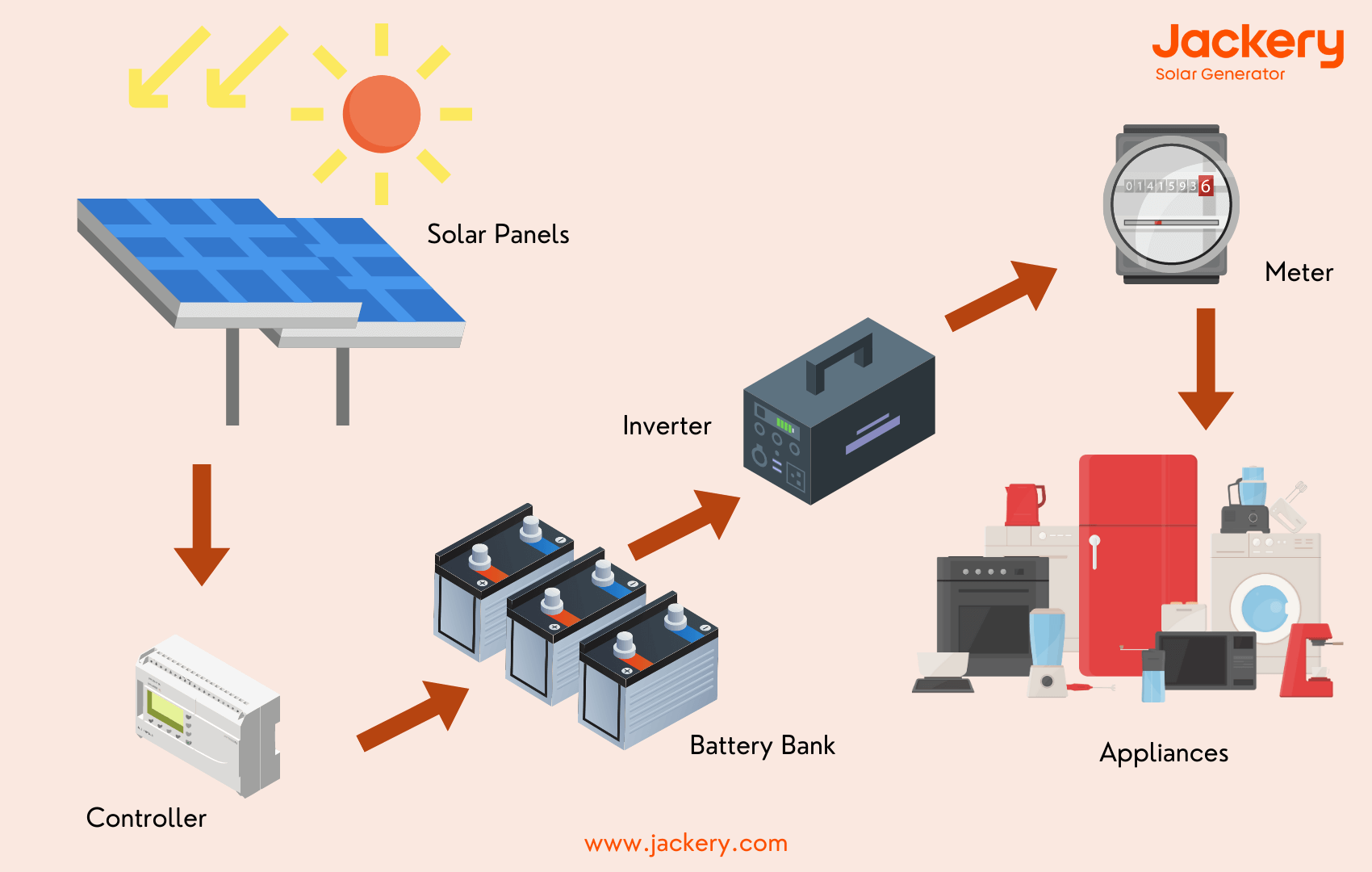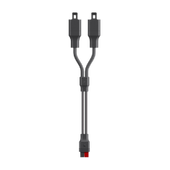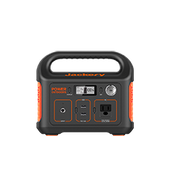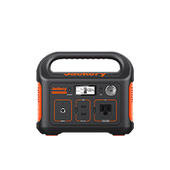How Do Solar Cells Work
When a massive power plant in the sky above us is spewing clean, uninterrupted electricity for free, why do we waste time drilling for oil and shoveling coal? Solar panels can transform the Sun's roiling ball of nuclear energy into an infinite, practical electricity supply. The Sun, a seething ball of nuclear energy, has enough energy to power our Solar system for another five billion years.

Solar energy is currently widely used. You might wear a quartz solar-powered watch or have a solar-powered calculator. Solar-powered lights are in gardens, and solar panels are frequently found on satellites and spacecraft. There is little doubt that solar energy will grow even more significantly as a renewable energy source in the future as global warming continues to endanger our ecosystem. But do you know how do solar cells work? How do solar panels or solar batteries work? You will find answers on this page.
What is A Solar Cell
An electronic device known as a solar cell converts sunlight directly into electricity. It is octagonal, roughly the size of an adult's palm, and bluish-black. Solar cells are frequently combined to create solar modules connected to larger solar panels yet have either blue or black slabs.
Like battery cells, solar panel cells are made to produce energy; however, unlike battery cells, which use chemicals, solar panel cells do it by soaking up sunlight. They are occasionally called photovoltaic (PV) cells since they generate electricity using sunshine. The transistors in microchips comprise silicon, which is also how solar cells function. A semiconductor is a type of substance, such as silicon.

The Development of Solar Cells
Most PV devices today produce an electric field inside a semiconductor like a PV cell using a single junction or interface. In a single-junction PV cell, only photons with energies equal to or higher than the band gap of the cell material can liberate an electron for an electric circuit.

Source: US Energy Information Administration
One technique to get around this restriction is using two (or more) different cells with another band gap and junction to produce a voltage. "Multi-junction" cells are what these are known as. Because multi-junction devices can convert more of the energy spectrum of light to electricity, they can attain a greater overall conversion efficiency. A multi-junction device is a stack of distinct single-junction cells arranged in decreasing order of band gap, as shown below.

Source: US Energy Information Administration
How Do Solar Cells Work
Semiconductors of the n- and p-types of silicon are used to create solar cells. P-type silicon is produced by mixing boron or gallium atoms, which have one fewer electron in their exterior energy level than silicon. An electron vacancy, sometimes known as a "hole," is generated in boron because it has one fewer electron than is necessary to make the bonds with the neighboring silicon atoms.
A solar cell comprises two layers of silicon: one of p-type and one of n-type. The n-type layer has too many electrons, and the p-type layer has too many positively charged holes. The n-type layer migrates into the gaps close to the intersection between the two layers (p-type layer). Consequently, an area around the connection known as the depletion zone is created, where the electrons fill the holes.
When all the gaps in the depletion zone have been filled with electrons, the p-type side haves negatively charged ions, and the n-type side now contains positively charged ions. The internal electric field created by the negative charges of these ions prevents the electrons from the n-type layer from entering the holes in the p-type layer.
When sunlight strikes a solar cell, silicon's electrons are evacuated, which causes "holes" to form—the voids the outgoing electrons left behind. If this occurs, the electric field will transport holes to the p-type layer and electrons to the n-type layer.
- Photons (light particles) pelt the cell's upper surface when sunlight shines.
- The photons (yellow blobs) transport energy through the cell at a downward angle.
- In the lower p-type layer, photons transfer their energy to electrons (green blobs).
- With this power, the electrons can overcome the handicap into the top n-type layer and break into the circuit.
- The lamp begins to glow as the electrons move across the circuit.

How Do Solar Cells Work in Bad Weather
How do solar cells work when the weather changes or when there are cloudy days? Does the outside temperature matter? For maximum solar energy production, you need a sunny day. However, it should be noted that solar panels lose some of their effectiveness during the sweltering summer months. On the other hand, a sunny winter day increases the effectiveness of solar panels.
Why? As the day gets warmer and the temperature rises, solar cells, essentially electronic, produce less voltage and electricity. The fact that solar panels function more effectively in lower temperatures does not necessarily translate into increased electricity production. Clouds can also make activities less enjoyable, but summers bring more prolonged sun exposure and fewer cloudy days.
How Do Solar Panels Work
The photovoltaic effect, a natural occurrence involving physics and chemistry that transforms solar energy into usable electricity, is how solar panels produce power. The solar cells in a module capture light energy when sunlight strikes it. Solar energy is transformed into a direct current by solar panels, then converted into the alternating current that fuels your devices.
- Solar Cells Absorb Photons:Photons are tiny solar light rays. When an electron is knocked loose by a photon, the solar cell develops a "hole."
- Solar Panel Produce Current:Solar cells use photons to create direct current (DC). Crystalline silicon is the main component of each solar cell, sandwiched between positive and negative conducting layers.
- Inverter Convert DC to AC: Solar cells can't generate enough current to power a house independently; you need an inverter to turn that current into something you can use.
- Converted Electricity:AC electricity leaves the inverter and travels to an external circuit before passing through your house. Solar energy can power light switches, appliances, televisions, and the rest of your home's electrical equipment.
- Store Extra Energy:You can use a solar battery to store extra energy or use a net metering program to resell it to your local utility company. Consider purchasing a solar storage battery if you prefer your system to operate off the grid.

Source: Byju’s Study Material
How Do Solar Batteries Work
When a device or system has an electrical surplus, batteries use chemical potential energy to store the extra electricity—solar storage batteries' store' energy like other batteries. As opposed to electrical terminal types, anode, and cathode are found in batteries.
- Sunlight into Electrical Flow: Solar panels allow photons to impact electrons and knock them away from atoms, converting sunlight into electrical flow. This causes an electrical flux and charges the particles. The more electricity is charged, the more daylight there is.
- Energy Conversion:As the solar panels produce power, it enters the battery via silicon-based wafers and circuits. In a nutshell, the electrical current that is straight or linear is known as direct current or DC. On the other hand, the current flow in AC, or alternating current, electricity can alternate between positive and negative.
- DC-Coupled Conversion:If your solar energy system is simply DC-coupled, the electricity enters your solar battery immediately. Additionally, DC electricity is kept instead of converted to AC and kept in that form.
- AC-Coupled Conversion:The procedure is slightly different if your solar panel system is AC-coupled. As before, your energy is captured as DC power when sunlight strikes the solar panels. However, the electricity then passes via an inverter and is instantly turned into AC electricity, which is ideal for usage.

Source: Sunlight Solar
Best Portable Solar Panels with Jackery
By enabling clean charging efficiency and accessibility on or off the grid, Jackery empowers outdoor adventure. As the leading maker of portable electricity and one of the world's largest producers of outdoor solar utilities, Jackery is currently a leader in the energy sector. We're a crucial front in the battle against climate change by reinventing sustainable energy for outdoor life.
Jackery portable solar panels can be folded and strapped for carrying and use. It makes the most of the Sun and converts it into clean energy thanks to one of the sector's top 25% efficiency rates. Use solar power and the Jackery power stations to charge your equipment. It is the cutting-edge off-grid solar-producing technology for improved backup management.

How Do Jackery Solar Panels Work
Jackery portable solar panels are built with monocrystalline solar cells and fitted with adjustable stands. The charging efficiency may be up to 25%. Utilize solar energy to its fullest potential. It is simple to connect your power station and solar panel. Connect your portable power station's DC input to the DC interface. A portable power station and solar panels are combined in the solar solution. It converts solar panels' energy into electrical power, then stored in a portable power station for later use.
- Collect Energy:Gather solar power by positioning the solar panels in the Sun.
- Store Power: A lithium battery is used to store energy from a solar panel and release it. The MPPT controller allows the inverter to convert DC/AC into electrical energy.
- Charge Appliances:By releasing stored energy, a range of equipment and appliances are powered.

Jackery SolarSaga Panels Series
There are mainly 3 SolarSaga products, including SolarSaga 200W, SolarSaga 100W, and SolarSaga 80W. Pairing the Solar Panel with your Power Station is easy. Connect the DC interface with the DC input of your portable power station.
Jackery SolarSaga 200W Solar Panel
The Jackery SolarSaga 200W solar panels are your best option if you want a solution that can power your entire home. Solar panels can generate more power under similar circumstances with a higher conversion rate of 24.3%. A Jackery Portable Power Station Explorer 2000 Pro can be fully charged in 2.5 hours using 6 SolarSaga 200.
- Solar panel stands firmly and securely thanks to its three kickstands.
- The ETFE-laminated case ensures the solar panel is durable enough for a prolonged lifespan.
- SolarSaga 200W enjoys a 5-year warranty.
|
Product |
Compatible With |
Recharging Time |
Conversion Efficiency |
|
Jackery SolarSaga 200W |
Explorer 2000 Pro + 6*SolarSaga 200 |
2.5H |
24.3% |
|
Explorer 2000 Pro + 4*SolarSaga 200 |
4H |
||
|
Explorer 2000 Pro + 2*SolarSaga 200 |
7.5H |
Jackery SolarSaga 100W Solar Panel
The Jackery SolarSaga 100W solar panel is ideal for outdoor enthusiasts due to its collapsible, lightweight, and easy-carry handle. The monocrystalline silicon solar cells and multi-layered cell technology enable the solar panels' higher conversion efficiency of 24.3%. The Jackery Explorer 300/500/1000/1500 power station is compatible with this solar panel, making it the perfect choice for off-grid camping and unplanned power outages.
- It weighs only 10.33 lbs.
- The Solar Saga 100 features two kickstands that can be placed firmly on any surface ground.
- Solar Saga 100 features 1* USB-C output port and 1* USB-A output port.
|
Product |
Compatible With |
Recharging Time |
Conversion Efficiency |
|
Jackery SolarSaga 100W |
Explorer 1500 Pro + 2*SolarSaga 100 |
4H |
24.3% |
|
Explorer 1000 + 2*SolarSaga 100 |
8H |
||
|
Explorer 500/300/240 + 1*SolarSaga 100 |
9.5/5/4H |
Jackery SolarSaga 80W Solar Panel
Both sides of the dual-sided Jackery SolarSaga 80W panels produce electricity. The back panel's extra-white glass increases conversion rates. It can survive severe conditions because it is certified as dustproof and waterproof to the IP68 standard.
- IP68 waterproof and dustproof certified against harsh weather conditions.
- A 2-meter extension cable is provided for extra charging distance applications.
- Made of 2.8mm low iron full toughened glass, giving high durability to the solar panel.
|
Product |
Compatible With |
Recharging Time |
Conversion Efficiency |
|
Jackery SolarSaga 80W |
Explorer 240/300/500 + 1*SolarSaga 80 |
4/6/9H |
25% |
|
Explorer 1000 + 2*SolarSaga 80 |
9H |
||
|
Explorer 1000 Pro + 2*SolarSaga 80 |
9H |
FAQs about How Solar Cells Work
The following are some frequently asked questions about how solar cells work:
1. How to make a solar cell?
Making your solar cell at home is simple; you only need to utilize items you already have and follow the instructions.
- Conductive Glass:An indium tin oxide residue is typically applied to conductive glasses.
- Titanium Dioxide Solution:In a glass beaker, combine titanium dioxide and ethanol; mix. The purest ethanol you can get should be used.
- Glass Coating:Wrap the glass in tape on three sides.
- Heat the Solar Cell:Put the solar cell into a transparent, heatproof beaker. Cook the container for 10 to 20 minutes after setting it on a hotplate and turning it on.
- Stain It with Tea:Tea includes anthocyanins, which effectively absorb visible light.
2. What is the electrical power point of a solar cell?
When exposed to direct sunlight, these various photovoltaic cells produce nearly the same amount of electrical power, measured in Watts and expressed as the product of voltage and current for each panel. Hence, P = V x I.
3. Why are solar cells made of semiconductors only?
The semiconductor material that makes up the PV cell can transmit electricity more effectively than an insulator but is less effective than a good conductor like a metal. If the energy of the electrons is greater than the necessary threshold energy, the photons can rapidly eject the electrons from it.
Final Thoughts
Solar cells convert the Sun's energy into electrical power through solar modules. This article helps to have a fundamental understanding of how solar cells work and how solar panels and solar batteries work. This page helps choose a solar panel for off-the-grid, camping, or backup usage. Moreover, Jackery is a central front in the fight against climate change, redefining the use of clean energy for outdoor life. In line with the growth of the solar cell industry, we are committed to creating the best solar panels.
Disclaimer:
The runtime mentioned for appliances powered by Jackery is for reference only. Actual runtime may vary under different conditions. Please refer to real-world performance for accurate results.













































































































Leave a comment